- Afrikaans
- Albanian
- Amharic
- Arabic
- Armenian
- Azerbaijani
- Basque
- Belarusian
- Bengali
- Bosnian
- Bulgarian
- Catalan
- Cebuano
- Corsican
- Croatian
- Czech
- Danish
- Dutch
- English
- Esperanto
- Estonian
- Finnish
- French
- Frisian
- Galician
- Georgian
- German
- Greek
- Gujarati
- Haitian Creole
- hausa
- hawaiian
- Hebrew
- Hindi
- Miao
- Hungarian
- Icelandic
- igbo
- Indonesian
- irish
- Italian
- Japanese
- Javanese
- Kannada
- kazakh
- Khmer
- Rwandese
- Korean
- Kurdish
- Kyrgyz
- Lao
- Latin
- Latvian
- Lithuanian
- Luxembourgish
- Macedonian
- Malgashi
- Malay
- Malayalam
- Maltese
- Maori
- Marathi
- Mongolian
- Myanmar
- Nepali
- Norwegian
- Norwegian
- Occitan
- Pashto
- Persian
- Polish
- Portuguese
- Punjabi
- Romanian
- Russian
- Samoan
- Scottish Gaelic
- Serbian
- Sesotho
- Shona
- Sindhi
- Sinhala
- Slovak
- Slovenian
- Somali
- Spanish
- Sundanese
- Swahili
- Swedish
- Tagalog
- Tajik
- Tamil
- Tatar
- Telugu
- Thai
- Turkish
- Turkmen
- Ukrainian
- Urdu
- Uighur
- Uzbek
- Vietnamese
- Welsh
- Bantu
- Yiddish
- Yoruba
- Zulu
welding pvc curtain
Welding PVC Curtains A Practical Guide
In industrial settings, the importance of maintaining safety and comfort cannot be overstated. One of the effective ways to ensure this is by utilizing PVC curtains. These versatile barriers not only protect workers from environmental hazards but also help to contain light, temperature, and noise within a workspace. When it comes to installation or modification of these curtains, welding is a crucial skill that can enhance the performance and longevity of the materials used. This article aims to provide a comprehensive overview of welding PVC curtains, including the benefits, techniques, and best practices associated with this method.
Understanding PVC Curtains
PVC (Polyvinyl Chloride) curtains are widely used in various industries, including manufacturing, food processing, and warehousing. They are designed to act as physical barriers that can be easily moved or removed when necessary. The primary advantages of using PVC curtains include
1. Safety They provide a clear barrier that can prevent unauthorized access to hazardous areas and protect workers from flying debris and equipment.
2. Versatility Available in various thicknesses and colors, PVC curtains can be tailored to fit different applications, from welding booths to cold storage areas.
3. Cost-Effectiveness Compared to permanent structures, PVC curtains are relatively inexpensive and can be installed without extensive downtime.
4. Ease of Use They can be opened and closed easily, allowing for quick access to different areas while still providing a level of protection.
The Importance of Welding PVC
Welding PVC curtains is essential for creating strong and durable seams. Unlike traditional sewing, welding provides a stronger bond that is resistant to tearing and can withstand the stresses of industrial environments. Moreover, welded seams are impervious to water and contaminants, making them suitable for harsh conditions.
Welding can also facilitate the customization of PVC curtains, allowing for specific dimensions, reinforcement of areas prone to wear and tear, and the integration of hardware such as hooks and mounting brackets.
Welding Techniques for PVC Curtains
There are several methods for welding PVC, of which the most common include
welding pvc curtain

1. Hot Air Welding This technique uses a hot air welding machine that heats the PVC material to the point where it becomes pliable. A filler rod can be added to reinforce the seam. Hot air welding is ideal for creating strong, flexible joints.
2. Wedge Welding Wedge welding is a faster method that involves heating the edges of the PVC with a welding wedge. The edges are then pressed together to create a solid bond. This technique is particularly effective for thicker materials.
3. Ultrasonic Welding This technique utilizes high-frequency ultrasonic vibrations to generate heat, melting the plastic at the joint. This method is especially useful for thin materials and produces clean, strong seams without the need for additional fillers.
Best Practices for Welding PVC Curtains
To ensure strong, high-quality welds, there are several best practices to keep in mind
1. Clean the Material Prior to welding, ensure that the PVC surfaces are clean and free from dust, grease, or any contaminants that can weaken the bond.
2. Choose the Right Material Select PVC material that suits your specific application. Thicker materials may require different welding techniques compared to thinner ones.
3. Control Temperature Monitor the temperature of the welding equipment closely. Too hot can damage the material, while too cold won't create a sufficient bond.
4. Practice Proper Alignment Ensure that the edges to be welded are properly aligned before commencing the welding process. Misalignment can result in weak seams and uneven edges.
5. Allow for Cooling Time After welding, provide adequate time for the seams to cool and harden before applying any stress to the curtain.
Conclusion
Welding PVC curtains is a practical and efficient solution for many industrial needs. By understanding the various welding techniques and adhering to best practices, businesses can enhance the safety, durability, and functionality of their PVC curtains. As industries continue to evolve, the demand for tailored safety solutions will only increase, making welding an indispensable skill for maintaining high standards in work environments. With properly welded PVC curtains, companies can protect their workforce and ensure seamless operations in their facilities.
-
High-Quality 냉장실용 커튼 for Efficient Cooling Durable PVC Coated Wire Mesh RollosNewsJul.06,2025
-
Antistatic PVC Strip Curtains – Superior Static Protection & Easy InstallationNewsJul.06,2025
-
Clear Freezer Curtains - Durable Vinyl & Plastic Curtains for Cold Storage SolutionsNewsJul.06,2025
-
Transparent PVC-Folie – Flexible & Durable Clear Plastic Sheets for Versatile UseNewsJul.05,2025
-
High-Quality Cold Room Door Curtains Durable PVC Strip Curtains for Cold StorageNewsJul.05,2025
-
Shop Yellow Ticking Stripe Curtains – Classic Style, Durable Fabric, Multiple Colors AvailableNewsJul.05,2025



